Report on Intercultural Issues in Business: Challenges and Solutions
VerifiedAdded on 2021/06/14
|8
|1976
|97
Report
AI Summary
This report examines the intercultural issues faced by a company with its base in Australia, operating with subsidiaries across different cultures. It identifies challenges such as communication gaps due to language differences, varying work styles, and the dominance of certain cultural groups within teams. The report highlights the risks associated with these issues, including misinterpretations, conflicts, and lack of motivation among employees. It recommends strategies to mitigate these challenges, including establishing effective communication strategies, providing cultural awareness training, recognizing individual needs, and fostering mutual understanding and acceptance among team members. Furthermore, the report emphasizes the importance of creating a supportive team structure and building personal connections to enhance trust and loyalty. Finally, it suggests implementing norms and punitive measures to prevent cultural discrimination and address any arising issues promptly.
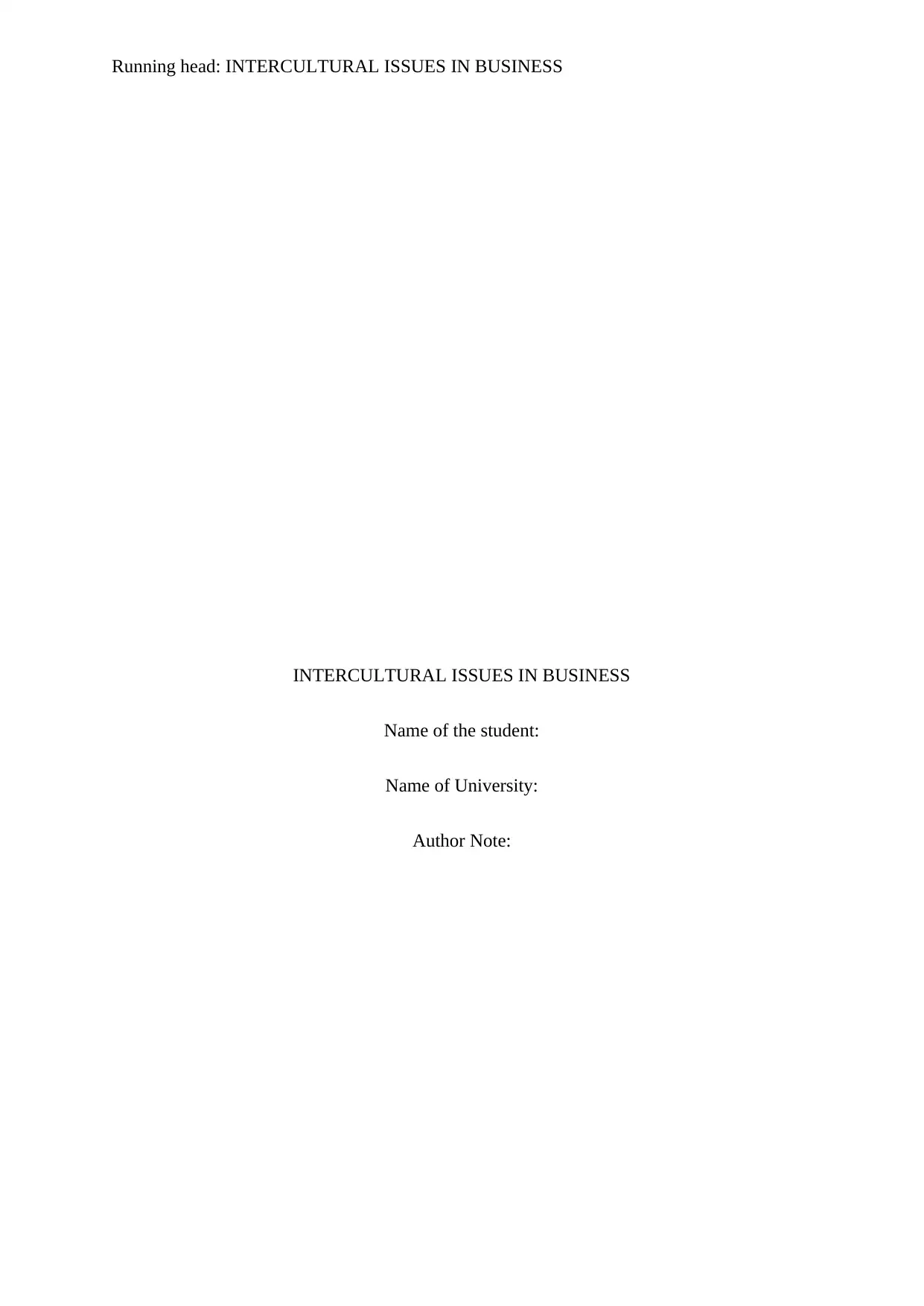
Running head: INTERCULTURAL ISSUES IN BUSINESS
INTERCULTURAL ISSUES IN BUSINESS
Name of the student:
Name of University:
Author Note:
INTERCULTURAL ISSUES IN BUSINESS
Name of the student:
Name of University:
Author Note:
Paraphrase This Document
Need a fresh take? Get an instant paraphrase of this document with our AI Paraphraser
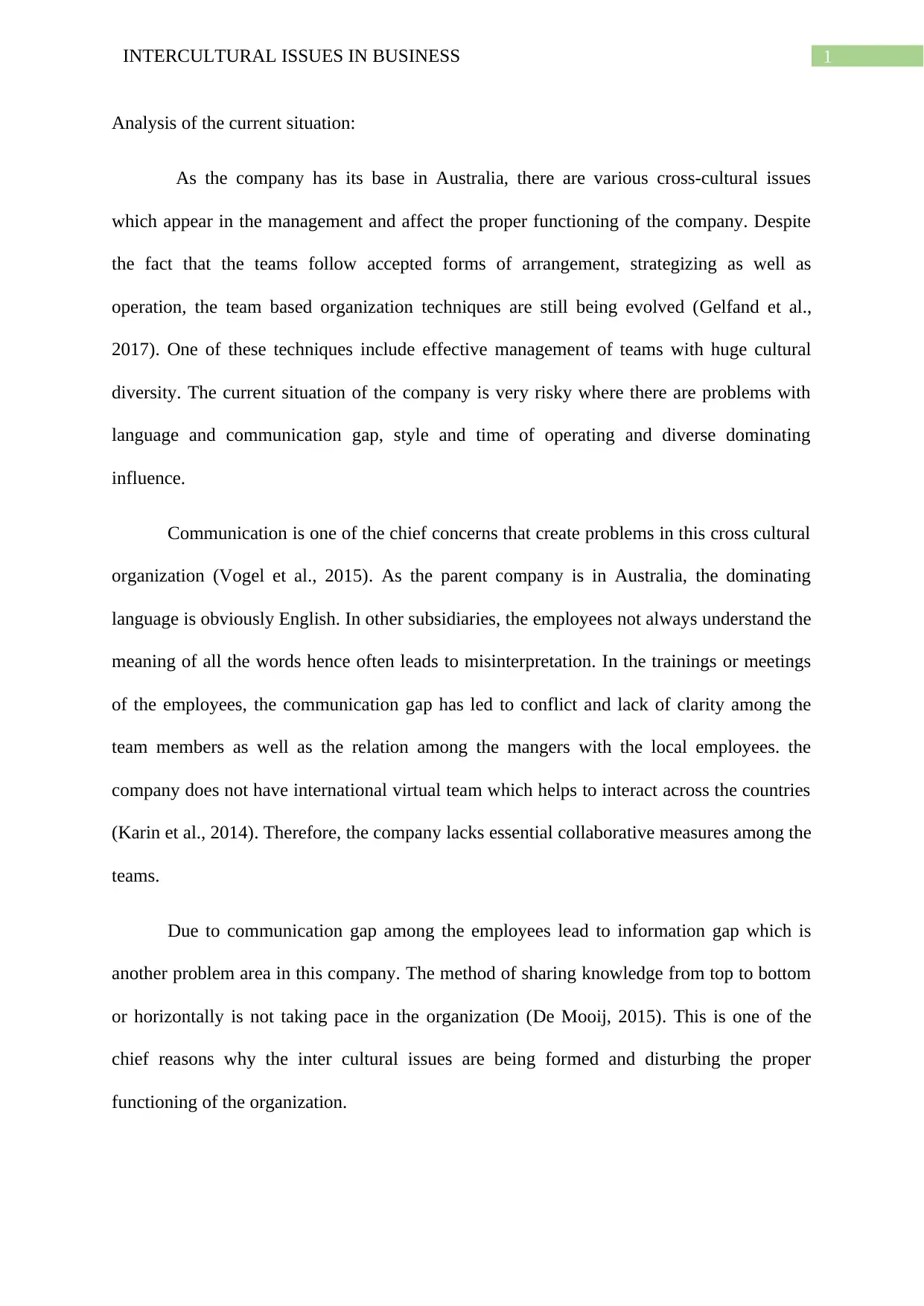
1INTERCULTURAL ISSUES IN BUSINESS
Analysis of the current situation:
As the company has its base in Australia, there are various cross-cultural issues
which appear in the management and affect the proper functioning of the company. Despite
the fact that the teams follow accepted forms of arrangement, strategizing as well as
operation, the team based organization techniques are still being evolved (Gelfand et al.,
2017). One of these techniques include effective management of teams with huge cultural
diversity. The current situation of the company is very risky where there are problems with
language and communication gap, style and time of operating and diverse dominating
influence.
Communication is one of the chief concerns that create problems in this cross cultural
organization (Vogel et al., 2015). As the parent company is in Australia, the dominating
language is obviously English. In other subsidiaries, the employees not always understand the
meaning of all the words hence often leads to misinterpretation. In the trainings or meetings
of the employees, the communication gap has led to conflict and lack of clarity among the
team members as well as the relation among the mangers with the local employees. the
company does not have international virtual team which helps to interact across the countries
(Karin et al., 2014). Therefore, the company lacks essential collaborative measures among the
teams.
Due to communication gap among the employees lead to information gap which is
another problem area in this company. The method of sharing knowledge from top to bottom
or horizontally is not taking pace in the organization (De Mooij, 2015). This is one of the
chief reasons why the inter cultural issues are being formed and disturbing the proper
functioning of the organization.
Analysis of the current situation:
As the company has its base in Australia, there are various cross-cultural issues
which appear in the management and affect the proper functioning of the company. Despite
the fact that the teams follow accepted forms of arrangement, strategizing as well as
operation, the team based organization techniques are still being evolved (Gelfand et al.,
2017). One of these techniques include effective management of teams with huge cultural
diversity. The current situation of the company is very risky where there are problems with
language and communication gap, style and time of operating and diverse dominating
influence.
Communication is one of the chief concerns that create problems in this cross cultural
organization (Vogel et al., 2015). As the parent company is in Australia, the dominating
language is obviously English. In other subsidiaries, the employees not always understand the
meaning of all the words hence often leads to misinterpretation. In the trainings or meetings
of the employees, the communication gap has led to conflict and lack of clarity among the
team members as well as the relation among the mangers with the local employees. the
company does not have international virtual team which helps to interact across the countries
(Karin et al., 2014). Therefore, the company lacks essential collaborative measures among the
teams.
Due to communication gap among the employees lead to information gap which is
another problem area in this company. The method of sharing knowledge from top to bottom
or horizontally is not taking pace in the organization (De Mooij, 2015). This is one of the
chief reasons why the inter cultural issues are being formed and disturbing the proper
functioning of the organization.
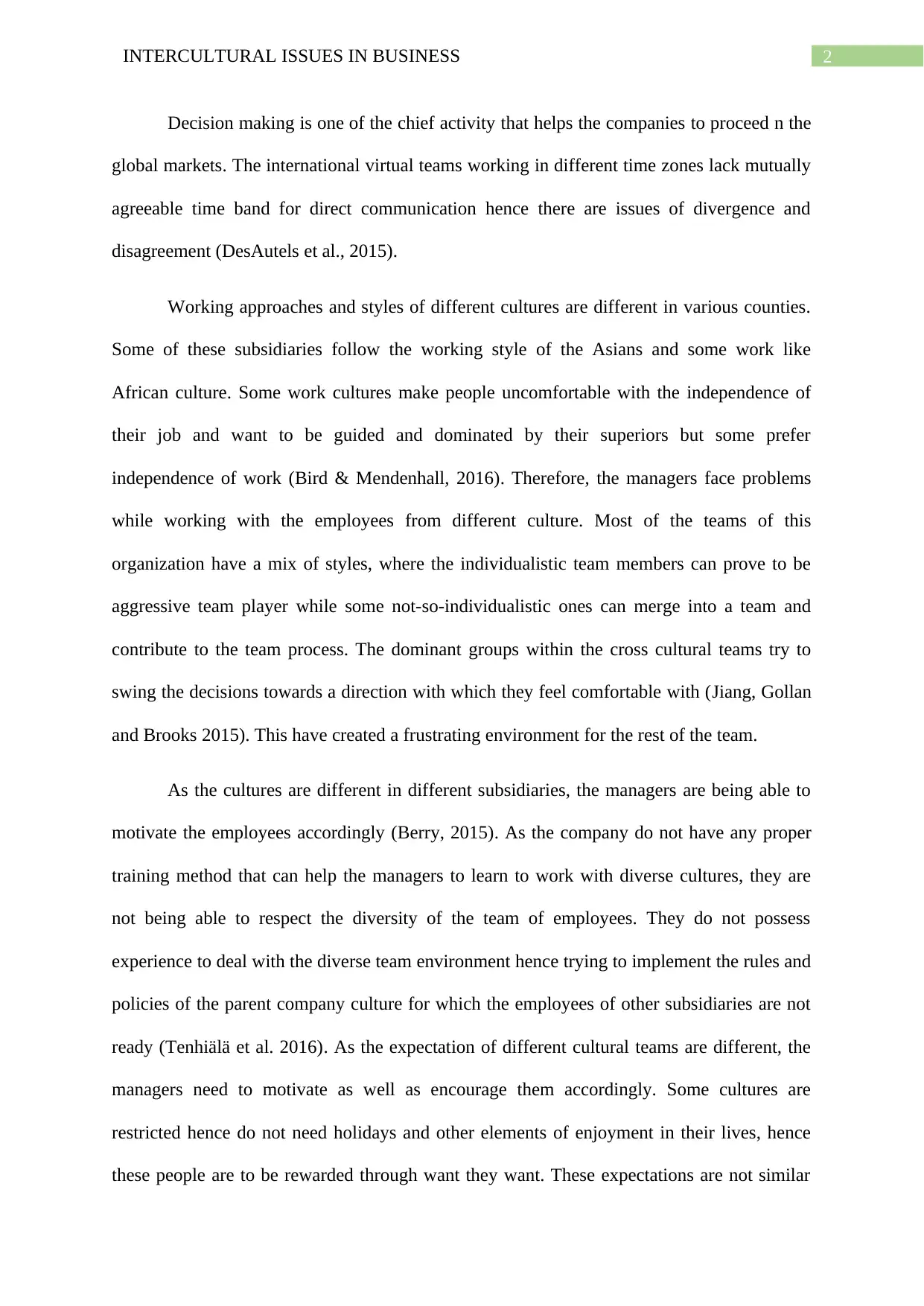
2INTERCULTURAL ISSUES IN BUSINESS
Decision making is one of the chief activity that helps the companies to proceed n the
global markets. The international virtual teams working in different time zones lack mutually
agreeable time band for direct communication hence there are issues of divergence and
disagreement (DesAutels et al., 2015).
Working approaches and styles of different cultures are different in various counties.
Some of these subsidiaries follow the working style of the Asians and some work like
African culture. Some work cultures make people uncomfortable with the independence of
their job and want to be guided and dominated by their superiors but some prefer
independence of work (Bird & Mendenhall, 2016). Therefore, the managers face problems
while working with the employees from different culture. Most of the teams of this
organization have a mix of styles, where the individualistic team members can prove to be
aggressive team player while some not-so-individualistic ones can merge into a team and
contribute to the team process. The dominant groups within the cross cultural teams try to
swing the decisions towards a direction with which they feel comfortable with (Jiang, Gollan
and Brooks 2015). This have created a frustrating environment for the rest of the team.
As the cultures are different in different subsidiaries, the managers are being able to
motivate the employees accordingly (Berry, 2015). As the company do not have any proper
training method that can help the managers to learn to work with diverse cultures, they are
not being able to respect the diversity of the team of employees. They do not possess
experience to deal with the diverse team environment hence trying to implement the rules and
policies of the parent company culture for which the employees of other subsidiaries are not
ready (Tenhiälä et al. 2016). As the expectation of different cultural teams are different, the
managers need to motivate as well as encourage them accordingly. Some cultures are
restricted hence do not need holidays and other elements of enjoyment in their lives, hence
these people are to be rewarded through want they want. These expectations are not similar
Decision making is one of the chief activity that helps the companies to proceed n the
global markets. The international virtual teams working in different time zones lack mutually
agreeable time band for direct communication hence there are issues of divergence and
disagreement (DesAutels et al., 2015).
Working approaches and styles of different cultures are different in various counties.
Some of these subsidiaries follow the working style of the Asians and some work like
African culture. Some work cultures make people uncomfortable with the independence of
their job and want to be guided and dominated by their superiors but some prefer
independence of work (Bird & Mendenhall, 2016). Therefore, the managers face problems
while working with the employees from different culture. Most of the teams of this
organization have a mix of styles, where the individualistic team members can prove to be
aggressive team player while some not-so-individualistic ones can merge into a team and
contribute to the team process. The dominant groups within the cross cultural teams try to
swing the decisions towards a direction with which they feel comfortable with (Jiang, Gollan
and Brooks 2015). This have created a frustrating environment for the rest of the team.
As the cultures are different in different subsidiaries, the managers are being able to
motivate the employees accordingly (Berry, 2015). As the company do not have any proper
training method that can help the managers to learn to work with diverse cultures, they are
not being able to respect the diversity of the team of employees. They do not possess
experience to deal with the diverse team environment hence trying to implement the rules and
policies of the parent company culture for which the employees of other subsidiaries are not
ready (Tenhiälä et al. 2016). As the expectation of different cultural teams are different, the
managers need to motivate as well as encourage them accordingly. Some cultures are
restricted hence do not need holidays and other elements of enjoyment in their lives, hence
these people are to be rewarded through want they want. These expectations are not similar
⊘ This is a preview!⊘
Do you want full access?
Subscribe today to unlock all pages.

Trusted by 1+ million students worldwide
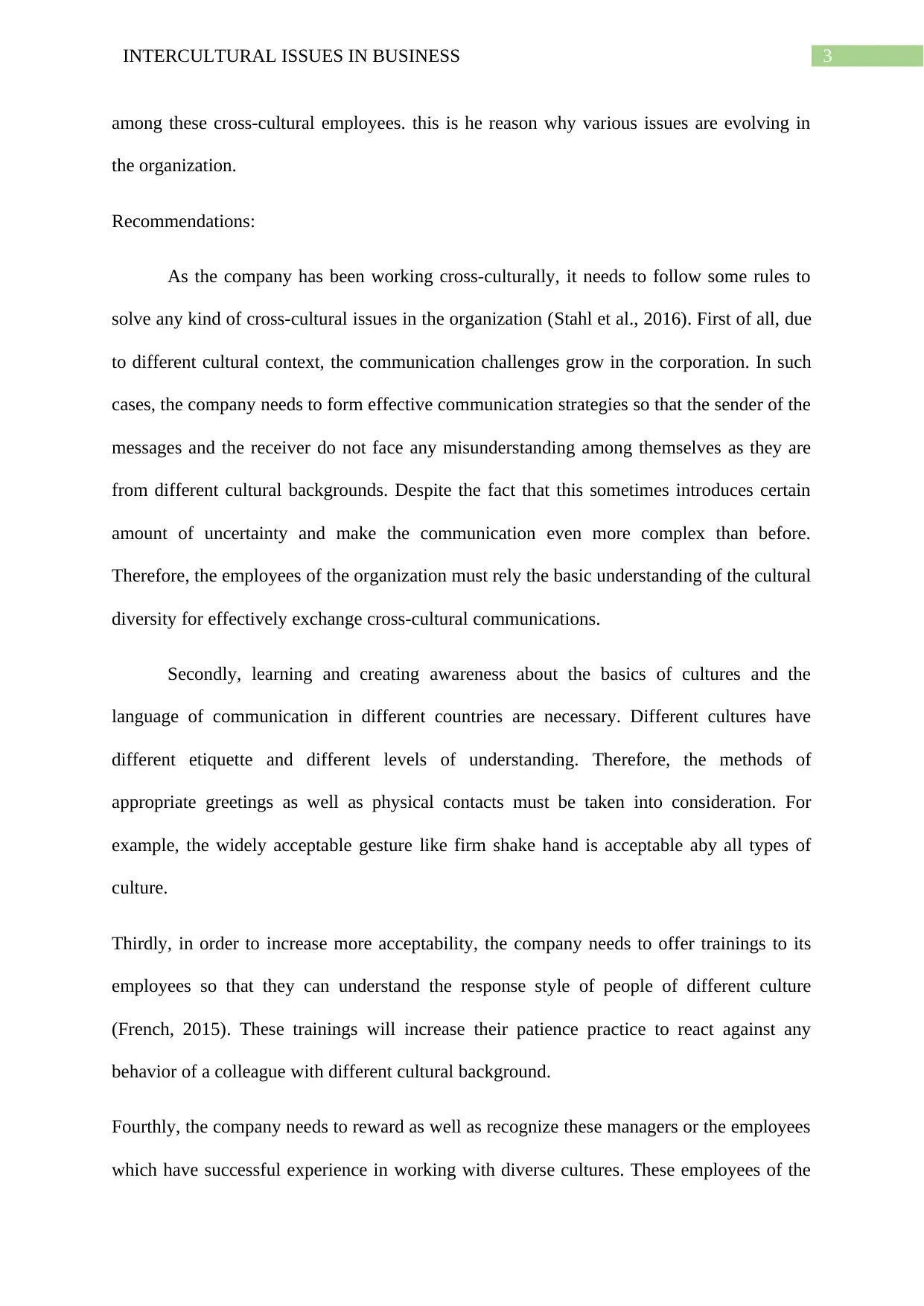
3INTERCULTURAL ISSUES IN BUSINESS
among these cross-cultural employees. this is he reason why various issues are evolving in
the organization.
Recommendations:
As the company has been working cross-culturally, it needs to follow some rules to
solve any kind of cross-cultural issues in the organization (Stahl et al., 2016). First of all, due
to different cultural context, the communication challenges grow in the corporation. In such
cases, the company needs to form effective communication strategies so that the sender of the
messages and the receiver do not face any misunderstanding among themselves as they are
from different cultural backgrounds. Despite the fact that this sometimes introduces certain
amount of uncertainty and make the communication even more complex than before.
Therefore, the employees of the organization must rely the basic understanding of the cultural
diversity for effectively exchange cross-cultural communications.
Secondly, learning and creating awareness about the basics of cultures and the
language of communication in different countries are necessary. Different cultures have
different etiquette and different levels of understanding. Therefore, the methods of
appropriate greetings as well as physical contacts must be taken into consideration. For
example, the widely acceptable gesture like firm shake hand is acceptable aby all types of
culture.
Thirdly, in order to increase more acceptability, the company needs to offer trainings to its
employees so that they can understand the response style of people of different culture
(French, 2015). These trainings will increase their patience practice to react against any
behavior of a colleague with different cultural background.
Fourthly, the company needs to reward as well as recognize these managers or the employees
which have successful experience in working with diverse cultures. These employees of the
among these cross-cultural employees. this is he reason why various issues are evolving in
the organization.
Recommendations:
As the company has been working cross-culturally, it needs to follow some rules to
solve any kind of cross-cultural issues in the organization (Stahl et al., 2016). First of all, due
to different cultural context, the communication challenges grow in the corporation. In such
cases, the company needs to form effective communication strategies so that the sender of the
messages and the receiver do not face any misunderstanding among themselves as they are
from different cultural backgrounds. Despite the fact that this sometimes introduces certain
amount of uncertainty and make the communication even more complex than before.
Therefore, the employees of the organization must rely the basic understanding of the cultural
diversity for effectively exchange cross-cultural communications.
Secondly, learning and creating awareness about the basics of cultures and the
language of communication in different countries are necessary. Different cultures have
different etiquette and different levels of understanding. Therefore, the methods of
appropriate greetings as well as physical contacts must be taken into consideration. For
example, the widely acceptable gesture like firm shake hand is acceptable aby all types of
culture.
Thirdly, in order to increase more acceptability, the company needs to offer trainings to its
employees so that they can understand the response style of people of different culture
(French, 2015). These trainings will increase their patience practice to react against any
behavior of a colleague with different cultural background.
Fourthly, the company needs to reward as well as recognize these managers or the employees
which have successful experience in working with diverse cultures. These employees of the
Paraphrase This Document
Need a fresh take? Get an instant paraphrase of this document with our AI Paraphraser
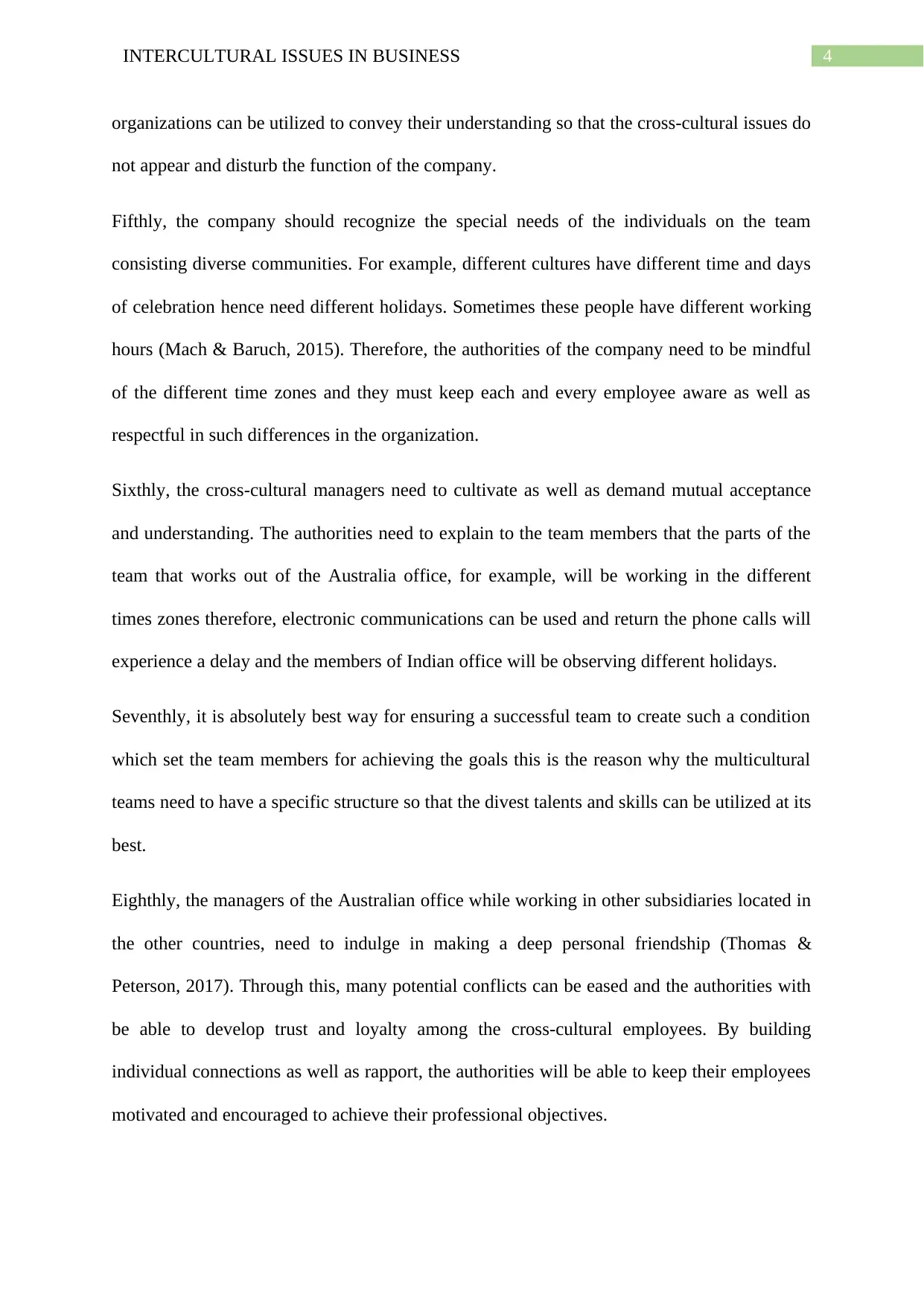
4INTERCULTURAL ISSUES IN BUSINESS
organizations can be utilized to convey their understanding so that the cross-cultural issues do
not appear and disturb the function of the company.
Fifthly, the company should recognize the special needs of the individuals on the team
consisting diverse communities. For example, different cultures have different time and days
of celebration hence need different holidays. Sometimes these people have different working
hours (Mach & Baruch, 2015). Therefore, the authorities of the company need to be mindful
of the different time zones and they must keep each and every employee aware as well as
respectful in such differences in the organization.
Sixthly, the cross-cultural managers need to cultivate as well as demand mutual acceptance
and understanding. The authorities need to explain to the team members that the parts of the
team that works out of the Australia office, for example, will be working in the different
times zones therefore, electronic communications can be used and return the phone calls will
experience a delay and the members of Indian office will be observing different holidays.
Seventhly, it is absolutely best way for ensuring a successful team to create such a condition
which set the team members for achieving the goals this is the reason why the multicultural
teams need to have a specific structure so that the divest talents and skills can be utilized at its
best.
Eighthly, the managers of the Australian office while working in other subsidiaries located in
the other countries, need to indulge in making a deep personal friendship (Thomas &
Peterson, 2017). Through this, many potential conflicts can be eased and the authorities with
be able to develop trust and loyalty among the cross-cultural employees. By building
individual connections as well as rapport, the authorities will be able to keep their employees
motivated and encouraged to achieve their professional objectives.
organizations can be utilized to convey their understanding so that the cross-cultural issues do
not appear and disturb the function of the company.
Fifthly, the company should recognize the special needs of the individuals on the team
consisting diverse communities. For example, different cultures have different time and days
of celebration hence need different holidays. Sometimes these people have different working
hours (Mach & Baruch, 2015). Therefore, the authorities of the company need to be mindful
of the different time zones and they must keep each and every employee aware as well as
respectful in such differences in the organization.
Sixthly, the cross-cultural managers need to cultivate as well as demand mutual acceptance
and understanding. The authorities need to explain to the team members that the parts of the
team that works out of the Australia office, for example, will be working in the different
times zones therefore, electronic communications can be used and return the phone calls will
experience a delay and the members of Indian office will be observing different holidays.
Seventhly, it is absolutely best way for ensuring a successful team to create such a condition
which set the team members for achieving the goals this is the reason why the multicultural
teams need to have a specific structure so that the divest talents and skills can be utilized at its
best.
Eighthly, the managers of the Australian office while working in other subsidiaries located in
the other countries, need to indulge in making a deep personal friendship (Thomas &
Peterson, 2017). Through this, many potential conflicts can be eased and the authorities with
be able to develop trust and loyalty among the cross-cultural employees. By building
individual connections as well as rapport, the authorities will be able to keep their employees
motivated and encouraged to achieve their professional objectives.
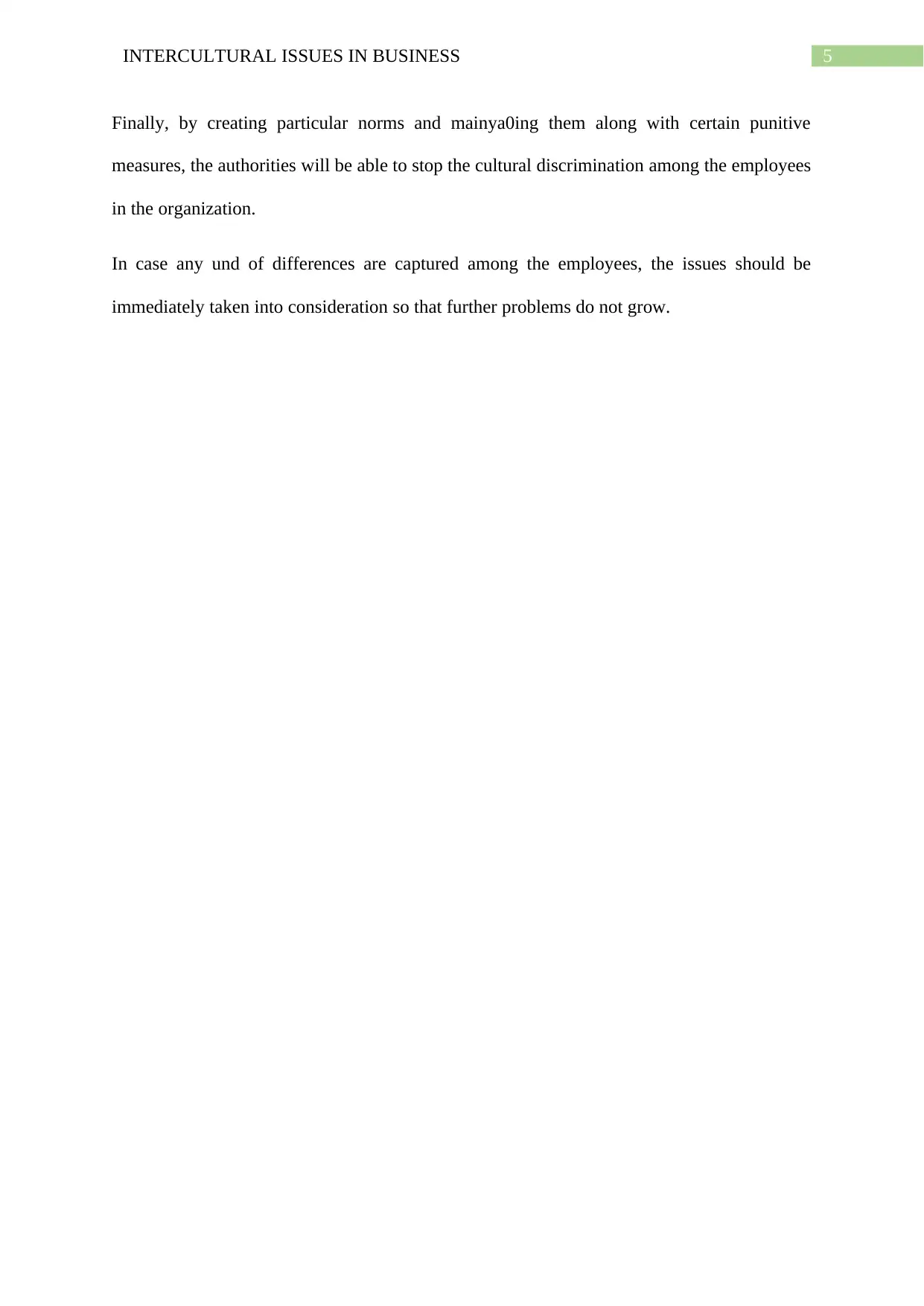
5INTERCULTURAL ISSUES IN BUSINESS
Finally, by creating particular norms and mainya0ing them along with certain punitive
measures, the authorities will be able to stop the cultural discrimination among the employees
in the organization.
In case any und of differences are captured among the employees, the issues should be
immediately taken into consideration so that further problems do not grow.
Finally, by creating particular norms and mainya0ing them along with certain punitive
measures, the authorities will be able to stop the cultural discrimination among the employees
in the organization.
In case any und of differences are captured among the employees, the issues should be
immediately taken into consideration so that further problems do not grow.
⊘ This is a preview!⊘
Do you want full access?
Subscribe today to unlock all pages.

Trusted by 1+ million students worldwide
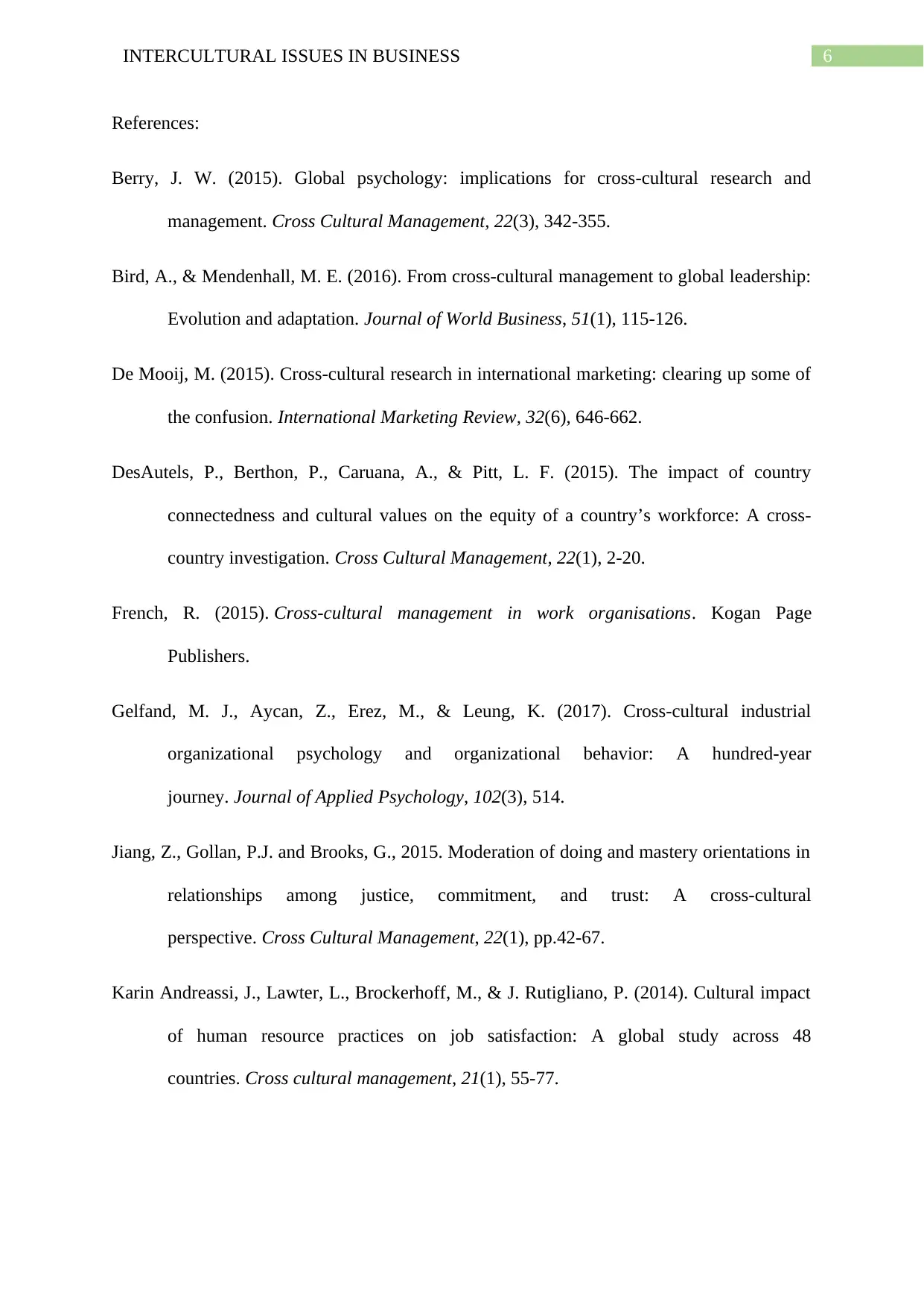
6INTERCULTURAL ISSUES IN BUSINESS
References:
Berry, J. W. (2015). Global psychology: implications for cross-cultural research and
management. Cross Cultural Management, 22(3), 342-355.
Bird, A., & Mendenhall, M. E. (2016). From cross-cultural management to global leadership:
Evolution and adaptation. Journal of World Business, 51(1), 115-126.
De Mooij, M. (2015). Cross-cultural research in international marketing: clearing up some of
the confusion. International Marketing Review, 32(6), 646-662.
DesAutels, P., Berthon, P., Caruana, A., & Pitt, L. F. (2015). The impact of country
connectedness and cultural values on the equity of a country’s workforce: A cross-
country investigation. Cross Cultural Management, 22(1), 2-20.
French, R. (2015). Cross-cultural management in work organisations. Kogan Page
Publishers.
Gelfand, M. J., Aycan, Z., Erez, M., & Leung, K. (2017). Cross-cultural industrial
organizational psychology and organizational behavior: A hundred-year
journey. Journal of Applied Psychology, 102(3), 514.
Jiang, Z., Gollan, P.J. and Brooks, G., 2015. Moderation of doing and mastery orientations in
relationships among justice, commitment, and trust: A cross-cultural
perspective. Cross Cultural Management, 22(1), pp.42-67.
Karin Andreassi, J., Lawter, L., Brockerhoff, M., & J. Rutigliano, P. (2014). Cultural impact
of human resource practices on job satisfaction: A global study across 48
countries. Cross cultural management, 21(1), 55-77.
References:
Berry, J. W. (2015). Global psychology: implications for cross-cultural research and
management. Cross Cultural Management, 22(3), 342-355.
Bird, A., & Mendenhall, M. E. (2016). From cross-cultural management to global leadership:
Evolution and adaptation. Journal of World Business, 51(1), 115-126.
De Mooij, M. (2015). Cross-cultural research in international marketing: clearing up some of
the confusion. International Marketing Review, 32(6), 646-662.
DesAutels, P., Berthon, P., Caruana, A., & Pitt, L. F. (2015). The impact of country
connectedness and cultural values on the equity of a country’s workforce: A cross-
country investigation. Cross Cultural Management, 22(1), 2-20.
French, R. (2015). Cross-cultural management in work organisations. Kogan Page
Publishers.
Gelfand, M. J., Aycan, Z., Erez, M., & Leung, K. (2017). Cross-cultural industrial
organizational psychology and organizational behavior: A hundred-year
journey. Journal of Applied Psychology, 102(3), 514.
Jiang, Z., Gollan, P.J. and Brooks, G., 2015. Moderation of doing and mastery orientations in
relationships among justice, commitment, and trust: A cross-cultural
perspective. Cross Cultural Management, 22(1), pp.42-67.
Karin Andreassi, J., Lawter, L., Brockerhoff, M., & J. Rutigliano, P. (2014). Cultural impact
of human resource practices on job satisfaction: A global study across 48
countries. Cross cultural management, 21(1), 55-77.
Paraphrase This Document
Need a fresh take? Get an instant paraphrase of this document with our AI Paraphraser
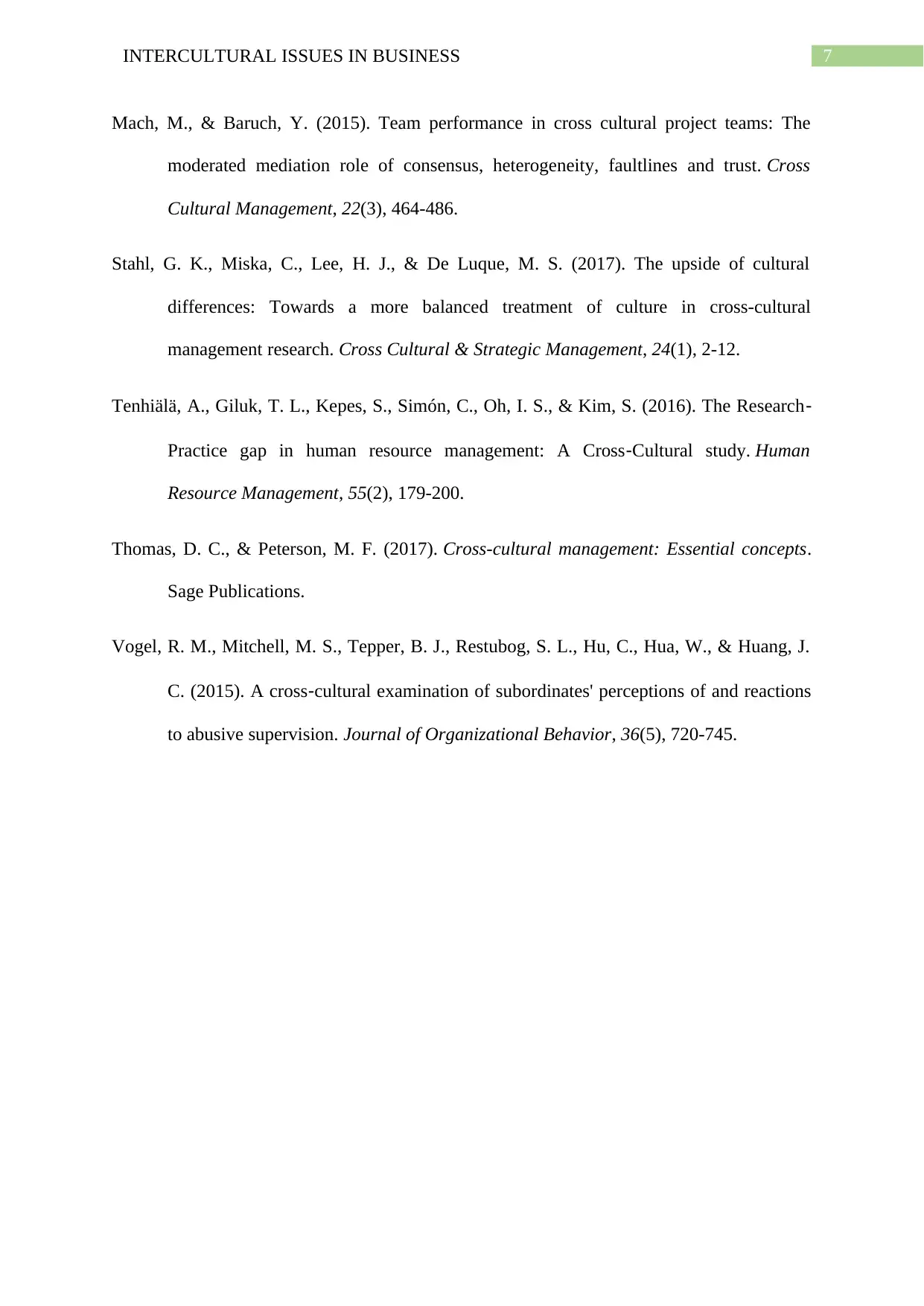
7INTERCULTURAL ISSUES IN BUSINESS
Mach, M., & Baruch, Y. (2015). Team performance in cross cultural project teams: The
moderated mediation role of consensus, heterogeneity, faultlines and trust. Cross
Cultural Management, 22(3), 464-486.
Stahl, G. K., Miska, C., Lee, H. J., & De Luque, M. S. (2017). The upside of cultural
differences: Towards a more balanced treatment of culture in cross-cultural
management research. Cross Cultural & Strategic Management, 24(1), 2-12.
Tenhiälä, A., Giluk, T. L., Kepes, S., Simón, C., Oh, I. S., & Kim, S. (2016). The Research‐
Practice gap in human resource management: A Cross‐Cultural study. Human
Resource Management, 55(2), 179-200.
Thomas, D. C., & Peterson, M. F. (2017). Cross-cultural management: Essential concepts.
Sage Publications.
Vogel, R. M., Mitchell, M. S., Tepper, B. J., Restubog, S. L., Hu, C., Hua, W., & Huang, J.
C. (2015). A cross‐cultural examination of subordinates' perceptions of and reactions
to abusive supervision. Journal of Organizational Behavior, 36(5), 720-745.
Mach, M., & Baruch, Y. (2015). Team performance in cross cultural project teams: The
moderated mediation role of consensus, heterogeneity, faultlines and trust. Cross
Cultural Management, 22(3), 464-486.
Stahl, G. K., Miska, C., Lee, H. J., & De Luque, M. S. (2017). The upside of cultural
differences: Towards a more balanced treatment of culture in cross-cultural
management research. Cross Cultural & Strategic Management, 24(1), 2-12.
Tenhiälä, A., Giluk, T. L., Kepes, S., Simón, C., Oh, I. S., & Kim, S. (2016). The Research‐
Practice gap in human resource management: A Cross‐Cultural study. Human
Resource Management, 55(2), 179-200.
Thomas, D. C., & Peterson, M. F. (2017). Cross-cultural management: Essential concepts.
Sage Publications.
Vogel, R. M., Mitchell, M. S., Tepper, B. J., Restubog, S. L., Hu, C., Hua, W., & Huang, J.
C. (2015). A cross‐cultural examination of subordinates' perceptions of and reactions
to abusive supervision. Journal of Organizational Behavior, 36(5), 720-745.
1 out of 8
Related Documents
Your All-in-One AI-Powered Toolkit for Academic Success.
+13062052269
info@desklib.com
Available 24*7 on WhatsApp / Email
![[object Object]](/_next/static/media/star-bottom.7253800d.svg)
Unlock your academic potential
Copyright © 2020–2025 A2Z Services. All Rights Reserved. Developed and managed by ZUCOL.





